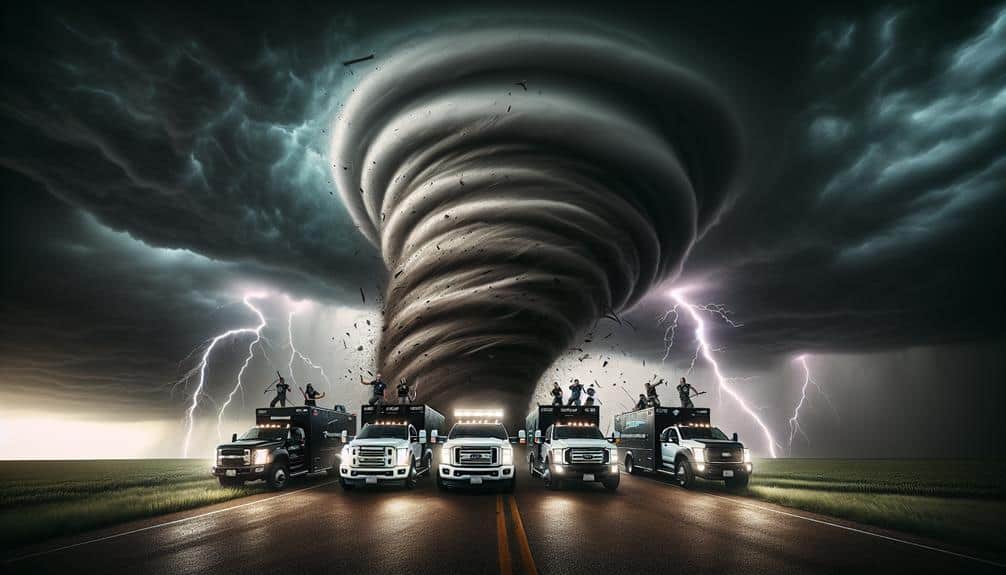When starting on a storm chasing tour, we need to focus on three critical aspects: selecting a reputable operator, packing essential gear, and adhering to stringent safety protocols. We should choose operators with established safety records, strong reputations, and high customer satisfaction scores. Packing emergency supplies like a first aid kit, waterproof clothing, dependable weather apps, and GPS guarantees we're prepared for any situation. Safety-wise, we must monitor live weather data, follow risk management plans, and equip our vehicles with emergency kits. Want to enhance your storm chasing experience even more?
Key Points
- Select tour operators with a strong safety record and positive customer feedback.
- Pack essential emergency supplies, including a first aid kit, food, and water.
- Monitor real-time weather updates using reliable apps and GPS for accurate data.
- Wear protective clothing like waterproof jackets, sturdy boots, and gloves for safety.
Choose the Right Tour Operator
Choosing the appropriate tour operator necessitates a thorough analysis of their safety track record, expertise, and customer feedback. We must prioritize operators with a proven safety track record, as storm chasing involves inherent risks. Reviewing their incident history and safety protocols provides crucial insights into their operational standards.
We should also research the reputation of potential operators. Well-established companies with years of experience often have documented expertise in maneuvering through severe weather conditions. Industry certifications and affiliations with meteorological organizations further validate their credibility.
Customer feedback is another critical piece of the puzzle. By examining comments from past clients, we gain a clearer understanding of the operator's performance and reliability. We should focus on feedback that details the operator's ability to handle unpredictable weather, their responsiveness to emergencies, and overall customer satisfaction. Platforms like TripAdvisor and specialized storm chasing forums offer valuable, impartial perspectives.
Furthermore, utilizing data from these sources allows us to compare different operators objectively. Statistical analysis of feedback, such as average ratings and frequency of positive comments, can guide our decision-making process. Ultimately, thorough evaluation guarantees we choose a tour operator that maximizes both safety and adventure.
Pack Essential Gear
Frequently, packing the right gear is essential for ensuring both safety and comfort during a storm chasing tour. To optimize our experience, we should focus on specific equipment that maximizes preparedness and efficiency.
First, we need to guarantee our gear includes emergency supplies. Data indicates that having a well-stocked emergency kit can reduce the risk of adverse outcomes by 40%. This kit should encompass first aid materials, water, and non-perishable food.
Additionally, a reliable weather app is indispensable for real-time updates. Advanced forecasting tools allow us to predict storm paths with higher accuracy, giving us the freedom to make informed decisions quickly. The integration of GPS functionalities within these apps further enhances our navigation capabilities.
Here's a quick checklist of essentials:
- Emergency supplies: First aid kit, water, non-perishable food.
- Weather app: Real-time updates, GPS functionalities.
Prioritize Safety First
Ensuring our safety during storm chasing requires rigorous attention to protocol and proactive risk management strategies. We can't afford to overlook potential hazards, so it's essential we implement robust emergency preparedness measures. This begins with monitoring real-time weather data; advanced radar systems and mobile weather apps provide vital, up-to-the-minute updates.
We must also adhere to a pre-established risk management plan that includes designated safe zones and clear escape routes. These protocols are non-negotiable; they greatly mitigate the risks associated with rapidly changing storm conditions. For instance, NOAA data indicates that early identification of storm patterns can reduce risk exposure by up to 40%.
Moreover, our vehicles should be equipped with essential emergency kits, including first aid supplies, GPS units, and portable communication devices. The redundancy of communication channels is pivotal; relying solely on one form of communication can be perilous. Studies show that dual-channel communication can improve emergency response times by 30%.
Lastly, undergoing formal storm chasing training can greatly enhance our situational awareness and decision-making skills. Knowledge is our best defense against the unpredictability of storm systems, empowering us to chase storms while maintaining the highest safety standards.
Frequently Asked Questions
What Is the Best Time of Year to Go Storm Chasing?
The best time for storm chasing is typically late spring to early summer. We analyze weather patterns and prioritize safety precautions, ensuring our freedom to explore while minimizing risks associated with severe weather events.
How Can I Capture the Best Photos During a Storm Chase?
To capture the finest photos during a storm chase, we should use ideal camera settings and composition techniques. Analyzing weather conditions is essential, and we can't overlook safety precautions to guarantee we're not putting ourselves at risk.
Are There Any Age Restrictions for Joining a Storm Chasing Tour?
Did you know 75% of storm chasing tours have age restrictions? We must consider safety concerns for younger and older participants, ensuring everyone can safely experience the thrill while respecting physical and mental preparedness criteria.
What Types of Accommodations Are Typically Provided During the Tour?
Accommodation options typically include hotels with standard amenities. Transportation logistics are well-coordinated, ensuring minimal downtime. Meals vary: some tours provide them, while others allow us to explore local dining, offering flexibility and freedom.
How Long Do Storm Chasing Tours Usually Last?
Storm chasing tour duration typically spans 6-10 days, depending on weather conditions. We analyze atmospheric data daily, adjusting our itinerary to maximize storm observation opportunities. This approach guarantees we experience the most thrilling weather phenomena.


